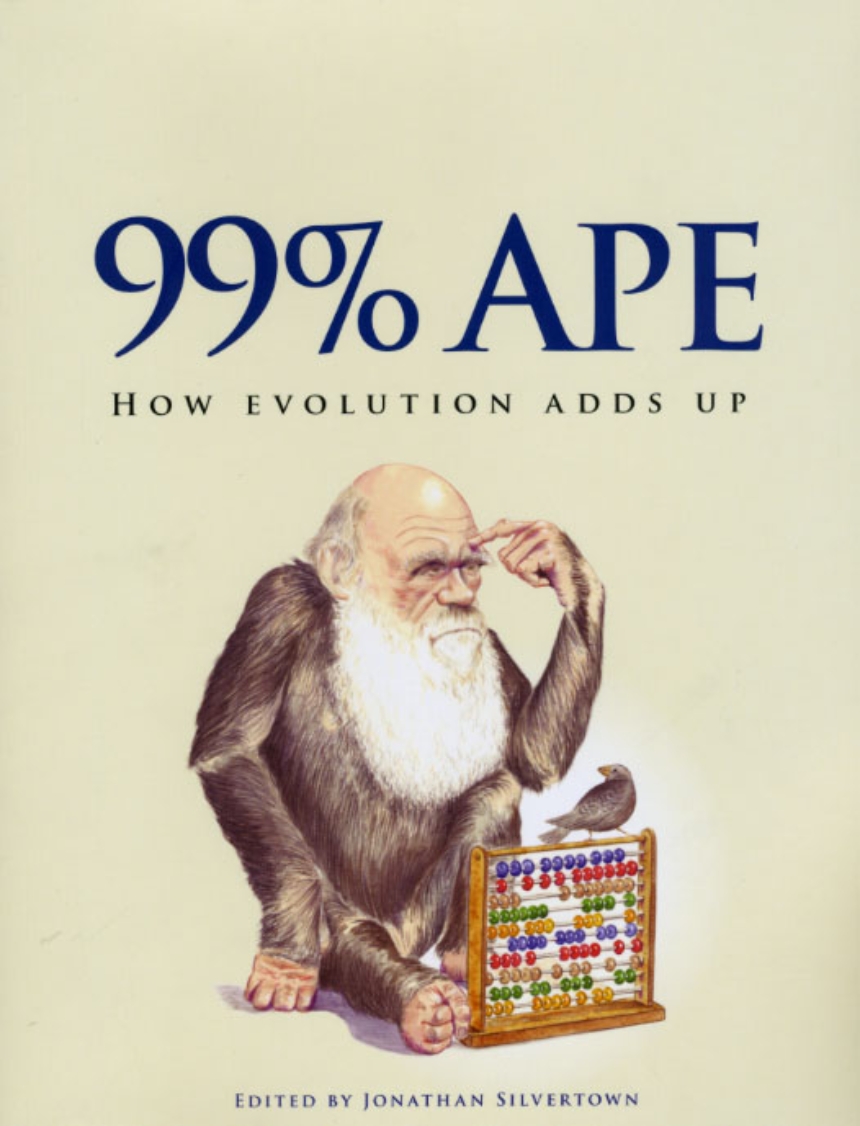99% Ape
How Evolution Adds Up
In his lifetime, Charles Darwin was roundly mocked for suggesting that humans were descended from apes, and even in our own day, the teaching of evolution remains controversial. But in the century and a half since the publication of On the Origin of Species, our increasingly sophisticated understanding of genetics has borne out Darwin’s theory: humans share 99% of their genes with chimps (and many even with grapes!).
99% Ape offers an accessible, straightforward introduction to evolution, beginning with Darwin’s discoveries and continuing through the latest genetic discoveries. Edited by Jonathan Silvertown, the volume brings together experts in a variety of fields pertinent to evolution, from paleobiology to planetary science, comparative anatomy to zoology, and even—for a discussion of legal battles surrounding the teaching of evolution—law. Interwoven with these varied accounts of evolution and its impact are vignettes from Darwin’s life that illustrate the continuity of thought that links Darwin’s work to today’s cutting-edge research.
Beautifully illustrated, 99% Ape is a perfect companion to the upcoming celebration of Darwin’s bicentennial and a bracing reminder of the important role evolution still has to play in our understanding of our origins—and our possible futures.
224 pages | 20 halftones, 225 color plates | 7 1/2 x 10 | © 2009
Biological Sciences: Anatomy, Biochemistry, Evolutionary Biology, Natural History, Physiology, Biomechanics, and Morphology
Reviews
Table of Contents
Acknowledgements
Origins
Chapter 1 99% Ape
Evolution liberates
Evolutionary trees
Darwin, apes & Victorians
Darwin’s insights
What’s in 1%?
Chapter 2. Darwin’s brilliant idea
Design without a designer
Canine friends in sickness and in health
Natural selection
Chapter 3. The tree of life
Scientific classification of species
Cracking the mystery of species
Ideas on trial
The geological timescale
Darwin’s evolving ideas
Branches and trees
Enter the star witness – DNA
Chapter 4. First life
The meaning of life
Life’s first spark
Earliest signs
Life in hot water
Extraterrestrials
Chapter 5. African genesis
In the beginning ...
The ‘prime’ animals
History from molecules
Body building
Chapter 6. An Eye for Darwin
Variety
Eye Design
Something old, something new, something borrowed, something blue
Chapter 7. A fish out of water
Becoming terrestrial
Fishy relations
Hiding in the deep blue sea
Extinct and extant amphibians
Fish fingers
Resurrecting genes
Many were called, few were chosen
Chapter 8. A whale of a problem
After the dinosaurs
Aquatic for life
Whale characters
Whale origins
SINEs point the way
Ancient whales
Steps to leglessness
Chapter 9. Feathered fossils
Fossilized families
German aviation and Chinese dragons
Chicken feathers
Forming feathers: an orderly death
Genes and fossils reconciled
New structures, same old genes
Diversity
Chapter 10. In the genes
The family face
Chromosome choreography
Genes for every occasion
Why be different?
Chapter 11. New species from old
On the Origin of…what?
Losing touch
Speedy speciation
Knowing your own
Homebound lives
The leaky boundaries of species
Chromosome doubling: a quick recipe for greens
No sex, please, we’re budding
Fossils and species
Chapter 12. Darwin’s finches
Evolution isles
The fame of the finch
From one species to fifteen
Beaks and seeds
Beaks and genes
A lifetime’s work
Chapter 13. The flowers of evolution
First plants
Russian dolls and malaria
The greening of the land
The rise of the flowering plants
New patterns among the green branches of the tree of life
A big flower with small beginnings
Madagascan star orchid
Chapter 14. The race from Africa
The end of the line for Homo
The human saga written in DNA
Technological advances
Oil-and-water, or a cocktail?
The Y in Asia
Neanderthals – a skeleton in our cupboard?
The race from Africa, timed by the molecular clock
Here and now
Chapter 15. Catch me if you can
Truce or consequences
Friend and foe
Evolving disease
Gene swapping
Ideal homes for microbes
Dangerous responses
Hitchhiking between hosts
Lousy evolution
Chapter 16. Darwin in mind
Evolutionary psychology
Hunter-gatherer hangovers
Culture club
Chapter 17. Why be good?
Good behaviour
Gameplay
The origin of morals
In the public eye
For as you were when first your eye I eyed
Chapter 18. The science of evolution
Evolution versus creation: science and non-science
The Scopes monkey trial
Creationism in disguise
Evolution and religion
Logos and mythos
Chapter 19. What next?
Are we still evolving?
Spectacles and evolution
Old age – when natural selection retires
The long view
Evolution in the Anthropocene
Sources
